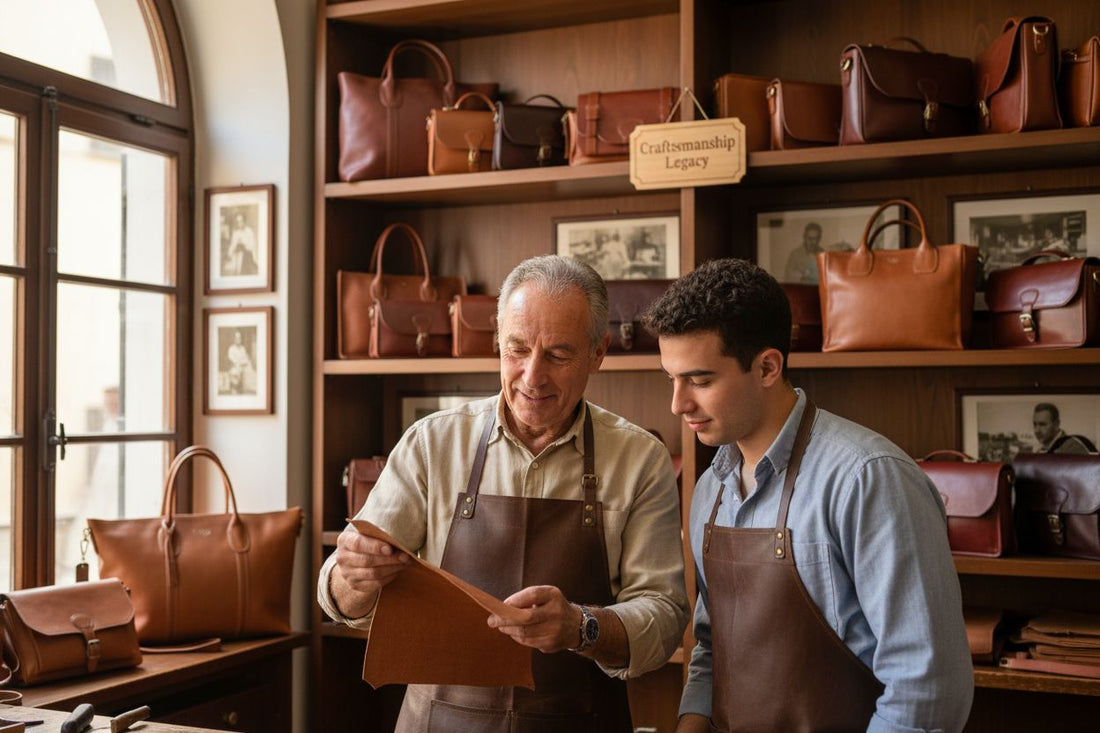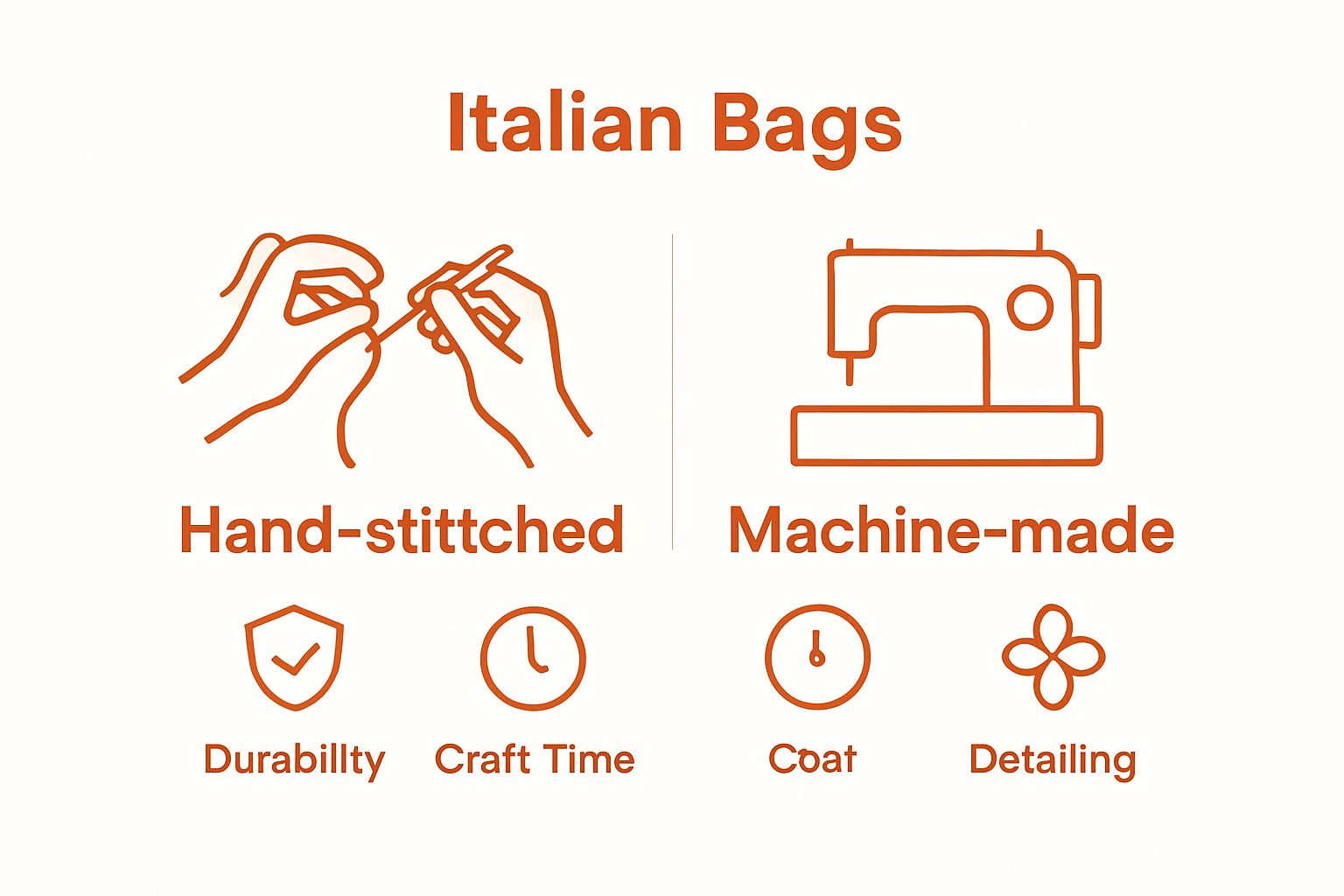
Understanding the History of Italian Bags: A Craftsmanship Legacy
Share
Italian bags are admired worldwide for their unmistakable elegance and fine craftsmanship. You might expect that mass production drives their popularity, but the truth is quite the opposite. Over 80 percent of premium Italian bags are still made by hand using traditional techniques passed down through generations. That dedication to heritage means every stitch tells a story, turning a simple accessory into a piece of living history.
Table of Contents
- The Origins Of Italian Bags: A Cultural Journey
- Key Craftsmanship Techniques In Italian Bag Making
- The Evolution Of Style: Influences And Trends
- Iconic Brands And Their Impact On Fashion
- Sustainable Practices And The Future Of Italian Leather Goods
Quick Summary
| Takeaway | Explanation |
|---|---|
| Italian bags are rooted in rich history. | Their origins reflect centuries of craftsmanship and cultural identity, influencing design and production standards. |
| Artisans prioritise quality leather selection. | Full-grain leather is chosen for its durability and aesthetic qualities, ensuring exceptional product longevity. |
| Traditional techniques are combined with technology. | Artisans use hand-stitching and advanced processes, balancing artistry with modern efficiency. |
| Sustainability is a growing focus in production. | The industry adopts eco-friendly practices, reducing environmental impact while maintaining luxury standards. |
| Iconic brands influence global fashion trends. | Italian designers create powerful cultural narratives, transforming bags into statements of identity and artistry. |
The Origins of Italian Bags: A Cultural Journey
The history of Italian bags is deeply rooted in a rich tapestry of cultural heritage, artisanal skill, and generational craftsmanship that stretches back centuries. Understanding this legacy requires exploring the profound connection between Italian leatherworking traditions and the societal contexts that nurtured these remarkable skills.
The Renaissance of Leather Crafting
During the medieval period in Italy, particularly in regions like Tuscany, leather production emerged as a sophisticated art form. Cities such as Florence and Venice became epicentres of leather craftsmanship, where guilds of skilled artisans developed intricate techniques passed down through generations. Research from the Italian Leather Consortium reveals that these early craftsmen established standards of quality that would define Italian leather production for centuries to come.
The Renaissance period marked a significant transformation in leather bag manufacturing. Wealthy merchant families and nobility began commissioning increasingly complex leather accessories, elevating bags from mere functional items to symbols of social status and artistic expression. Craftsmen began experimenting with advanced tanning techniques, intricate decorative methods, and innovative design approaches that would become hallmarks of Italian leather production.
Cultural Significance and Technological Evolution
Italian bags were never just accessories; they represented complex narratives of social mobility, artistic innovation, and regional identity. Each bag told a story of its origin, reflecting the unique characteristics of the region where it was crafted. Historical research from the Leather Museum in Arzignano demonstrates how technological advancements and cultural exchanges shaped leather production techniques.
By integrating traditional hand-crafting methods with emerging technologies, Italian artisans created a unique approach to bag manufacturing. This method prioritised quality over quantity, individual skill over mass production, and aesthetic beauty alongside functional design. You can read more about the benefits of Italian handbags to understand how these historical foundations continue to influence contemporary leather goods.
The journey of Italian bags is a testament to the enduring power of craftsmanship, where each stitch and fold carries the weight of centuries of cultural and artistic innovation.
To help readers quickly compare the key advancements in Italian bag making across different historical eras, the following table summarises transformations in style, materials, and technology discussed throughout the article.
| Historical Era | Key Advancements | Influence on Italian Bags |
|---|---|---|
| Medieval Period | Emergence of artisan guilds, refined tanning | Establishment of quality standards and skill |
| Renaissance | Complex commissions, innovative decoration | Bags became status symbols and works of art |
| 1950s-1960s | International reputation for innovation | Focus on functionality and sophistication |
| Contemporary Era | Smart tech, sustainable materials, new designs | Blend of tradition with technology and ethics |
Key Craftsmanship Techniques in Italian Bag Making
Italian bag making transcends mere manufacturing, representing a sophisticated art form where meticulous techniques and generational knowledge converge to create exceptional leather goods. Understanding these intricate craftsmanship methods reveals why Italian bags are globally renowned for their unparalleled quality and aesthetic excellence.
Traditional Leather Selection and Preparation
The foundation of exceptional Italian bag making lies in rigorous leather selection. Italian artisans prioritise full-grain leather, which retains the natural grain and inherent strength of the animal hide. Research from the Italian National Leather Association highlights that superior leather undergoes extensive evaluation, considering factors such as:
- Texture consistency
- Natural grain integrity
- Minimal imperfections
- Durability potential
- Colour uniformity
Preparing leather involves complex tanning processes that have been refined over generations. Traditional vegetable tanning, predominantly practised in Tuscany, transforms raw hides into supple, durable materials using natural tannins extracted from tree bark. This method not only produces environmentally sustainable leather but also ensures each bag develops a unique patina over time.
Precision Cutting and Artisanal Construction
Cutting leather requires extraordinary skill and precision. Master craftsmen employ techniques passed through family lineages, understanding how to maximise each leather section’s potential. Expert analysis from the Leather Craftsmanship Institute reveals that experienced artisans can determine optimal cutting angles and patterns that minimise waste while preserving leather quality.
Construction involves intricate hand-stitching techniques that machine production cannot replicate. Artisans use traditional methods like saddle stitching, where two threads interlock, creating stronger, more durable seams.
 You can explore more about Italian handbag manufacturing techniques to appreciate the complexity behind each meticulously crafted piece.
You can explore more about Italian handbag manufacturing techniques to appreciate the complexity behind each meticulously crafted piece.
Finishing and Quality Validation
The final stage of bag making involves meticulous finishing processes. Each bag undergoes rigorous quality checks, with artisans examining every detail from edge painting to hardware attachment. This commitment to perfection ensures that only bags meeting the most stringent standards receive final approval, embodying the true essence of Italian craftsmanship.
This table outlines the primary craftsmanship techniques in Italian bag making, clarifying each stage’s main focus and importance for final bag quality as described in the article.
| Craftsmanship Stage | Main Focus | Importance for Quality |
|---|---|---|
| Leather Selection and Preparation | Choosing full-grain leather, vegetable tanning | Forms the durable, unique foundation |
| Precision Cutting | Accurate leather sectioning with minimal waste | Maximises usable material and shape integrity |
| Artisanal Construction | Hand-stitching, saddle stitching | Ensures strength, durability, and aesthetics |
| Finishing and Quality Validation | Detailing, hardware checks, edge painting | Guarantees only flawless products reach market |
The Evolution of Style: Influences and Trends
The landscape of Italian bag design represents a dynamic interplay between historical heritage and contemporary innovation, where each era brings transformative perspectives that reshape aesthetic and functional approaches to leather accessories.
Cultural and Artistic Movements
Italian bag design has been profoundly influenced by broader artistic movements, reflecting societal shifts and creative expressions. From the ornate elegance of Art Nouveau to the minimalist principles of Modernism, designers have consistently translated cultural zeitgeists into leather craftsmanship. Research from the Fashion and Design Museum in Milan reveals how artistic currents fundamentally reshape accessory design philosophies.
Notable design influences include:
- Post-war economic reconstruction aesthetics
- Minimalist design principles
- Global cross-cultural exchange
- Technological advancement integration
- Sustainable fashion movements
The 1950s and 1960s marked a particularly significant period, when Italian designers began establishing international reputations for innovative bag designs that balanced functionality with aesthetic sophistication. Brands started recognising bags not merely as accessories, but as statements of personal identity and cultural expression.
Technological and Material Innovations
Technological advancements have dramatically transformed bag design, introducing revolutionary materials and manufacturing techniques. Textile research from the Italian National Research Council demonstrates how synthetic materials, advanced leather treatments, and precision engineering have expanded design possibilities.
Contemporary Italian bag designers now integrate smart technologies, explore sustainable production methods, and experiment with unconventional materials while maintaining traditional craftsmanship principles. This approach ensures that innovation complements rather than replaces generational skills. You can explore our guide on understanding Italian leather craftsmanship to appreciate the delicate balance between tradition and innovation.
Global Fashion Dynamics
The global fashion ecosystem has increasingly recognised Italian bags as pinnacles of design excellence. International runways, fashion magazines, and style influencers consistently celebrate the nuanced elegance and technical mastery inherent in Italian leather accessories. This global validation has simultaneously pressured and inspired Italian designers to continually reinvent and refine their approach, ensuring that each collection represents both timeless tradition and contemporary vision.
Iconic Brands and Their Impact on Fashion
Italian bag brands have transcended mere commercial enterprises, emerging as cultural ambassadors that shape global fashion narratives and redefine luxury through extraordinary craftsmanship and visionary design philosophies. Their influence extends far beyond manufacturing, representing intricate stories of creativity, innovation, and national identity.
Pioneering Design Philosophies
Several Italian brands revolutionised bag design by challenging conventional manufacturing paradigms. Research from the Fashion Business Institute demonstrates how these brands transformed leather accessories from functional items into statements of artistic expression. Their approach integrated:
- Innovative material experimentation
- Architectural design principles
- Cultural storytelling through accessories
- Precision engineering
- Emotional connection with consumers
Pioneering brands like Gucci and Prada did not merely create bags; they constructed narratives that resonated with global audiences, elevating leather accessories from practical items to symbols of personal identity and social aspiration.
Technological and Aesthetic Innovations
Iconic Italian brands consistently pushed technological boundaries while maintaining deep respect for traditional craftsmanship. Design innovation studies from Milan Polytechnic reveal how these brands integrated cutting-edge technologies with time-honoured manufacturing techniques. Contemporary designers experiment with sustainable materials, smart technologies, and advanced production methodologies that respect both environmental considerations and artisanal traditions.
The strategic approach of these brands involves continuous reinvention while preserving core design principles. You can read more about the benefits of Italian handbags to understand how these iconic brands maintain their exceptional reputation.
Global Cultural Influence
Italian bag brands have fundamentally reshaped global fashion perceptions, transforming leather accessories into powerful cultural statements. Their influence extends beyond aesthetic trends, representing complex narratives of national creativity, technological innovation, and artistic expression. International fashion weeks, luxury markets, and global style publications consistently celebrate the nuanced excellence embodied by these iconic Italian brands, cementing their status as global design leaders who continually redefine luxury through exceptional craftsmanship.

Sustainable Practices and the Future of Italian Leather Goods
The Italian leather industry stands at a critical intersection of traditional craftsmanship and environmental responsibility, reimagining production methods that honour generational skills while addressing contemporary ecological challenges. This transformative approach represents a profound commitment to sustainable innovation and ethical manufacturing.
Ecological Transformation in Leather Production
Research from the Italian Environmental Protection Agency highlights the leather sector’s comprehensive strategies for reducing environmental impact. Sustainable practices now encompass a holistic approach that goes beyond mere material selection, integrating:
- Circular economy principles
- Water conservation techniques
- Renewable energy integration
- Carbon footprint reduction
- Biodegradable material development
Traditional tanning processes, historically known for significant chemical usage, are being reimagined through breakthrough technologies that minimise ecological disruption. Vegetable tanning methods, already prevalent in Italian leather production, are being further refined to create even more environmentally friendly outcomes.
Technological Innovation and Ethical Manufacturing
Contemporary Italian leather manufacturers are pioneering revolutionary production methodologies that challenge traditional industrial paradigms. Advanced research from the National Research Council of Italy demonstrates how innovative technologies enable more sustainable and ethical manufacturing processes.
Innovations include developing leather alternatives from agricultural waste, exploring bio-based materials, and implementing precision manufacturing techniques that dramatically reduce resource consumption. You can explore insights about the future of the Italian leather industry to understand these transformative approaches.
Global Sustainability Leadership
The Italian leather industry is positioning itself as a global leader in sustainable manufacturing, demonstrating that luxury and environmental consciousness are not mutually exclusive. By integrating cutting-edge technologies, respecting artisanal traditions, and maintaining an unwavering commitment to quality, Italian leather producers are creating a new paradigm of responsible luxury that resonates with environmentally conscious global consumers.
Bring Italian Craftsmanship Into Your Everyday Life
Are you inspired by the rich legacy of Italian bag making, yet struggle to find accessories that truly reflect genuine heritage and skill? Discover how the tradition of full-grain leather selection, artisanal hand-stitching, and meticulous finishing—described in our article—lives on in every item at San Rocco Italia. When you hold one of our handbags, you experience centuries of innovation and dedication, all handcrafted by Italian artisans who keep these time-honoured techniques alive.

Do not just read about craftsmanship, make it part of your world. Explore our curated collections, all selected for authenticity, quality, and timeless design. See the benefits of Italian handbags brought to life and learn more about the future of Italian leather industry. Begin your own story of Italian elegance today at San Rocco Italia.
Frequently Asked Questions
What defines the craftsmanship legacy of Italian bags?
The craftsmanship legacy of Italian bags is characterised by meticulous techniques and generational knowledge that have evolved over centuries. To understand this legacy, explore the various artistry methods used in leather selection, tanning, and stitching that contribute to the exceptional quality of these bags.
How have cultural movements influenced the design of Italian bags?
Cultural movements have played a significant role in shaping the design of Italian bags, with influences ranging from Art Nouveau to Modernism. To see how these movements reflect societal changes, examine historical design trends and their impact on contemporary aesthetics over the past decades.
What materials are traditionally used in the production of Italian bags?
Traditional Italian bags are made primarily from full-grain leather, selected for its natural qualities and durability. To understand material choices, consider how specific tanning processes, like vegetable tanning, enhance leather characteristics while promoting sustainability.
How can I identify quality craftsmanship in Italian bags?
Quality craftsmanship in Italian bags can be identified by examining features such as the stitching method, leather texture, and overall construction. To assess craftsmanship standards, look for details like hand-stitched seams and the use of high-grade materials that ensure long-lasting durability.
What role does technology play in modern Italian bag making?
In modern Italian bag making, technology enhances both production efficiency and design innovation while respecting traditional methods. To appreciate this integration, observe how contemporary artisans employ advanced techniques alongside generations-old practices to create unique pieces.
Why is sustainability important in the Italian leather industry?
Sustainability is crucial in the Italian leather industry as it redefines production methods to minimise environmental impact while ensuring quality. To recognise this shift, consider how Italian producers adopt eco-friendly tanning processes and circular economy principles within their operations.


